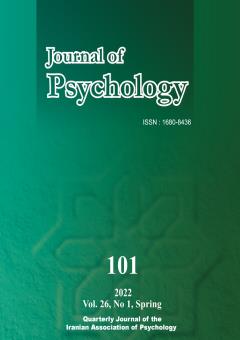-
-
List of Articles
-
Open Access Article
1 - Predicting Suicidal Thoughts Based on Parental Psychological Control: The Mediating role of Mindfulness
zahra eghdami Mahboubeh Fouladchang -
Open Access Article
2 - Prevalence of Premenstrual Dysphoric Symptoms in Iranian Women and its Relationship with Difficulty in Emotional Regulation and Change in the Symptoms during COVID-19 Pandemic
Seyedeh Zahra Mousavi Razieh Khorramabadi -
Open Access Article
3 - Psychometric properties and confirmatory factor analysis of the Iranian version of Smartphone Addiction Scale (SAS)
شادی حاج حسینی Ladan Fata Ali Fathi-Ashtiani -
Open Access Article
4 - The Effectiveness of Pennsylvania Resilience Program Training on Academic Life Style: Academic Health Preventing Behaviors
reza darabi mehdi arabzadeh hassan heidari hossein davoodi -
Open Access Article
5 - Investigating and comparing the development of cognitive intelligence، emotional intelligence and spiritual intelligence from adolescence to adulthood
Marzieh Sadat Sajadinezhad Soghra Akbari Chermahini -
Open Access Article
6 - model of structural relations between dimensions of personal and social identity elements and their effects on students of Tehran universities' national identity
Mohammad solgi -
Open Access Article
7 - Normalization of the Cognitive Questionnaire about Body and Health (cabah)
فریده نرگسی farzad zandi alireza mokhberi maryam khadirzare -
Open Access Article
8 - The Role of Pathological Personality Traits, Early Maladaptive Schemas and Emotional Schemas in Predicting Personality Disorders of Cluster “B”
Mohammad Valipour Behnaz Shid Anbarani Fatemeh Davoodi Hamidreza Aghamohamadian Shaerbaf Alireza Gol -
Open Access Article
9 - The Modeling between Motivational Strategies and Metacognitive Self- regulation with Peer-assisted Learning in Students
kazem fathtabar mehrdad hamednia Milad Abedi Ghelich gheshlaghi -
Open Access Article
10 - Teacher student relationship and help seeking: the mediating role of achievement goals and achievement motivation
سمانه سادات موسوی شریف Zahra Naghsh sogand ghasemzadeh
-
The rights to this website are owned by the Raimag Press Management System.
Copyright © 2017-2025







